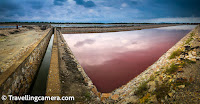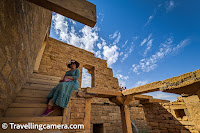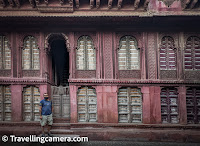Bhangarh Fort is located in the Alwar district of Rajasthan and is considered one of the most interesting historical places in India and is also popularly known as the most haunted place in India. It was built by Raja Bhagwant Das in the 16th century for his younger son, Madan Singh. This fort is surrounded by various legends and tales that have been involving the site in myths and horror for centuries. This fort complex lies at the edge of the Sariska Tiger Reserve and has received notoriety not only for ghostly happenings but also for its beautiful architecture and historical value.
Historical Background
Bhangarh Fort was constructed in 1573 by Raja Bhagwant Das, a member of the influential Kachwaha Rajput clan; he built this fort for his son, Madho Singh I. The boom town was marked by grand palaces, temples, markets, and havelis. The prosperity of Bhangarh was not to last long, however, and the town fell into ruins under mysterious circumstances to be abandoned.
Architectural Grandeur
This architectural blueprint of the fort is an absolutely brilliant combination of Rajput and Mughal styles, which quite genuinely reflects the grandeur characteristic of structures built in Rajasthan. The Bhangarh Fort is divided into several sections, such as palaces, temples, havelis, and marketplaces, while put together in a way that rather reflects the intricacy of ancient Indian urban planning.
Important Architectural Features:
Entrance Gates: The fort complex consists of four major entry gates — Lahori Gate, Ajmeri Gate, Phulbari Gate, and Delhi Gate. These four gates lead one to the interior regions of the fort, where remnants of temples, palaces, and the main fortress can be found.
Inside the fort are many well-preserved temples of Lord Hanuman, Shiva, and Gopinath, pointing to the cultural and religious importance attached to it when it was at its best.
Main palace: The main palace is constructed at the back end of the fort and is a multi-story building partially in ruins today. Once, the palace used to be witnessed with minute stone carvings and beautiful architectural designs, reflecting the era's grandeur.
Market Area: The old marketplace, Johari Bazaar, still seems to retain the remains of busy commercial activities which once proceeded here. The ruin of the shops gives some suggestion of the thriving economy in the fort.
Legends and Myths of Bhangarh Fort
Many legends and myths are associated with Bhangarh Fort, which makes the Fort all the more eerie. The most common legend is that of a black magician named Singhia and his ill-fated love affair with Princess Ratnavati of Bhangarh.
Legend has it that Singhia was some black magician who fell for Princess Ratnavati. Knowing very well that he would never win her heart, Singhia tried to use magic to enchant a perfume that was being bought by the princess and hoped that it might turn into love for her. But the princess could sense the evil intentions of Singhia and threw the bottle out, turning it into a boulder that crushed Singhia to death. On his deathbed, Singhia cursed the fort that led to its doom and brought its ruin.
Paranormal Activities and Hauntings
Bhangarh Fort is said to be haunted and held by paranormal activities with a spooky atmosphere. Several visitors have witnessed some strange occurrence which occurs in the town, such as an unaccountable disembodied sounds and voice, ghostsly apparitions, and several have witnessed apparitions surrounding the fort. The other theory about the occurrence of such tragic mysterious decline is that there was a curse thrown by Singhia, causing the inhabitants of the town to kill themselves or run away from the location.
Due to these ghostly activities, a board has been erected near the fort by ASI warning the visitors not to venture into the premises in the dark hours after sunset or before sunrise. This only adds to the mystique and charm of the fort, thereby being the dream of many thrill-seekers and paranormal enthusiasts.
Best Time to Visit
Best time to visit Bhangarh Fort is winters, October to March as the weather in Rajasthan is pleasantly warm and lovely while visiting the outdoor ruins. Even in the day visiting the fort is perfect, especially to witness its architectural grandeur and enjoy a great sight of the surrounding hills without the scorching summer heat.
How to reach Bhangarh Fort
Location: Bhangarh Fort is at a distance of 85 kilometers from Jaipur and around 20 kilometers from Sariska Tiger Reserve.
By Road: The fort can be reached pretty easily via road transport as one can hire a taxi or even drive from Jaipur or Delhi. Locally, buses are available to the town of Dausa and further connect to Bhangarh.
By Train: The nearest railway station is Dausa, which can also be reached easily from major cities like Jaipur and Delhi.
By Air: The nearest airport is Jaipur International Airport, that is, 90 km from the fort.
Places to Visit
Bhangarh Fort is close to other attractions in the following places.
Sariska Tiger Reserve: This wildlife sanctuary is close to Bhangarh, carrying an immense amount of biodiversity. It is a good place for all those nature lovers.
Ajabgarh Fort: This fort also holds its mysterious stories; it is situated near Bhangarh. From this fort, one can get breathtaking views of the surrounding landscape.
Bala Quila (Alwar Fort): The royal fort in Alwar stands testament to Rajasthan's history and architecture. Certain existing conservation efforts that sustain the fort are:
Bhangarh Fort is currently under preservation work so that its history and structural construction are preserved. The major part of the maintenance work was carried out by the Archaeological Survey of India. One half of the fort seems to still be in a semi-ruined state, which has turned it into an even more secretive and mysterious place.
Bhangarh Fort is more than a historical monument; it stands out as the place where legend meets mystery and history clashes to provide a unique experience for those touring in the area. A history buff, an investigator in paranormal activities, or a curious traveler, all of whom need to visit Bhangarh Fort to unravel the rich past of Rajasthan amidst myths and tales that both attract and chill them. A visit here isn't just to see the ruins; it is also a step towards being associated with stories that never lose their appeal and continue to make chills run down people's spines that make Bhangarh one of India's most mystifying places.
Related Blogposts:
 Amber Fort in Rajasthan : The Pearl of Jaipur's Rajput Architecture
Amber Fort in Rajasthan : The Pearl of Jaipur's Rajput Architecture
 Chand Baori in Abhaneri: A Marvel of Ancient Indian Architecture in Rajasthan
Chand Baori in Abhaneri: A Marvel of Ancient Indian Architecture in Rajasthan
 Bhandarej Baori: An Ancient Stepwell of Rajasthan's Heritage
Bhandarej Baori: An Ancient Stepwell of Rajasthan's Heritage
.jpg) Tour de Churu Streets having grand havelis with marvelous fresco paintings | Haveli Heritage Tour Rajasthan, India
Tour de Churu Streets having grand havelis with marvelous fresco paintings | Haveli Heritage Tour Rajasthan, India
 Beautiful Vyas Chhatris in Jaisalmer, Rajasthan || the most unusual sunset point built in a cremation ground
Beautiful Vyas Chhatris in Jaisalmer, Rajasthan || the most unusual sunset point built in a cremation ground
 Magnificent Cenotaphs at the Bada Bagh, Jaisalmer, Rajasthan || Exorbitant Ticket Prices can be a deterrent to anyone visiting the place
Magnificent Cenotaphs at the Bada Bagh, Jaisalmer, Rajasthan || Exorbitant Ticket Prices can be a deterrent to anyone visiting the place
 An interesting drive from Kuldhara to Khaba Fort, Dedha, Jaisalmer, Rajasthan || The Journey was definitely worth the visit to this beautiful little fort
An interesting drive from Kuldhara to Khaba Fort, Dedha, Jaisalmer, Rajasthan || The Journey was definitely worth the visit to this beautiful little fort
 A half day detour to Sambhar Salt Lake, Rajasthan from NH48 || What makes India's Largest Inland Salt Lake worth visiting in winters?
A half day detour to Sambhar Salt Lake, Rajasthan from NH48 || What makes India's Largest Inland Salt Lake worth visiting in winters?
 A fulfilling stop at Mandore in Jodhpur, Rajasthan || The old seat of the Rathore clan and also the birthplace of Mandodari
A fulfilling stop at Mandore in Jodhpur, Rajasthan || The old seat of the Rathore clan and also the birthplace of Mandodari
 The Golden Fort of Jaisalmer, Rajasthan || A thriving, pulsating mini city within the walls of the fort
The Golden Fort of Jaisalmer, Rajasthan || A thriving, pulsating mini city within the walls of the fort
 The splendid architecture of Patwon ki Haveli in Jaisalmer, Rajasthan || One of the most opulent of the havelis in Jaisalmer
The splendid architecture of Patwon ki Haveli in Jaisalmer, Rajasthan || One of the most opulent of the havelis in Jaisalmer
 The Abandoned Village of Kuldhara near Jaisalmer, Rajasthan || Facts and Fables about why the Paliwal Brahmins abandoned this village of their ancestors
The Abandoned Village of Kuldhara near Jaisalmer, Rajasthan || Facts and Fables about why the Paliwal Brahmins abandoned this village of their ancestors
 The Amazing Pokaran Fort near Jaisalmer, Rajasthan || A beautiful structure that effortlessly blends with the desert landscape it is built in
The Amazing Pokaran Fort near Jaisalmer, Rajasthan || A beautiful structure that effortlessly blends with the desert landscape it is built in
 Vedi Temple inside KumbalGarh Fort, Rajasthan - 3 Storey Octagonal structure standing strong on 36 pillars around world's second largest wall
Vedi Temple inside KumbalGarh Fort, Rajasthan - 3 Storey Octagonal structure standing strong on 36 pillars around world's second largest wall














.jpg)
















.jpg)

.jpg)
Comments